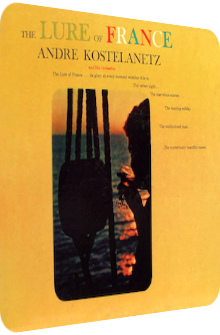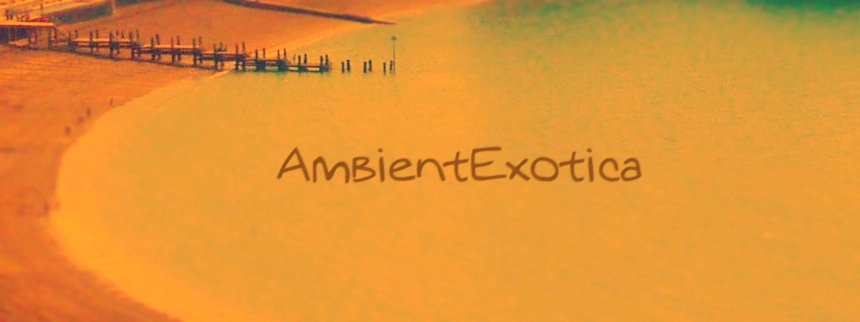
Andre Kostelanetz
Lure Of France
1957
La France? Ce n'est pas exotique! Martinique… bien sûr. Tahiti… aussi. Mais la France? Au contraire, back in the 50's, the mainland of France was as esoteric and exotic a destination as large parts of Old Europe and the Caribbean. Russian conductor and arranger Andre Kostelanetz (1901–1980) was pressed time and again by the management of Columbia Records to carefully select the most luring pieces of various countries and biotopes, be it in the forms of Kostelanetz' greatest symphonic Exotica opus Lure Of The Tropics (1954) and its foil Lure Of Paradise (1959), or the shape of more specific destinations such as Lure Of Spain (1957) and, of course, Lure Of France.
As usual, there are the same two markers that prevent Lure Of France to be truly associated with the Exotica genre: firstly, it is recorded in 1957 when the genre only just began to rose to some sort of fame. Kostelanetz therefore neglects bongos, congas or organs, all of them instruments that would admittedly be out of place in the given context anyway. Secondly, the material itself is mostly based on classics by French composers. Again, no complaints, nothing peculiar at all. So the only whimsical, infinitesimally tiny trace of Exotica could emanate from the topos of introducing the French mode de vie to a US-American globetrotter. Arrangement-wise, the typical cliché hodgepodge is fulfilled… and exceeded. Rustic accordions à la Montmartre meet auroral strings a l'Avignon as well as airy flutes and brass accentuations. Fans of Milt Raskin's Kapu and Dominic Frontiere's Pagan Festival (both 1959) will surely relate to the accordion-heavy sounds. And there is another treat on this eleven-track LP: three compositions from the feather of Claude Debussy neglect anything French and sound enormously enchanting, quite a bit symphonic-exotic and – who would have thought it – luring.
The album starts with two medleys, each of them comprising two compositions. The gateway to France leads through France, or to be more precise, is found next to Paul Durand’s Mademoiselle De Paris and Hubert Giraud’s Sous Le Ciel De Paris (Under Paris Skies) from the eponymous movie of 1951. The opening medley is decidedly gleeful and saccharine. The strings have bathed in technicolor, either whirring through the air in effervescent movements or in a pointillistic pizzicato style. The accordion must not be missed, and its inclusion here is delicately clichéd and carries the whole composition, making it slightly more intimate than the large amount of strings could ever accomplish. The curious but welcome appearance of wind chimes rounds the setting off, with Under Paris Skies introducing alto flutes and clarinets in front of euphonious brass eruptions and double bass blebs. The melody is world-famous even to those listeners who do not know the song title. Unfortunately, Kostelanetz goes all melodramatic on this one and enlarges the strings too much. To make matters worse, the strings are then gyrating in higher tone regions. A humbler approach would have been more appreciated and apt.
Up next is a medley of Joseph Kosma’s Bonjour Paris and Georges Boulanger’s My Prayer. Kosma’s composition is first coated in hatched colors of duskiness and then gives in to romantic notions which are aptly filled with lead violins and purposely diffuse string scents which occasionally rise and wash over the listener. Boulanger’s My Prayer resides in the same spectrum and perfectly meshes, but is otherwise much more awash with light and glittering strings, finishing this medley in a cozy, less syrupy state.
Lorenz Hart’s and Richard Rodgers’ Mimi is next, a splendidly dynamic rush through bustling French cities, everything floats by, is particularly polylayered. Echoey castanets (in France?) as well as various brass and accordion entanglements create layers of drops and arpeggiated driblets. This one is less French and could even be mistaken for a symphonic Exotica piece, were it not for its fame and Hollywood-rooted melody. The third medley follows and features Charles Trénet’s La Mer and Joseph Kosma’s Autumn Leaves; whereas La Mer is an uplifting transmutation with sparkling sunlight-resembling string spirals on gentle ocean waves, the arrangement of Autumn Leaves is eminently unexpected due to its film noir tenor saxophone and the yearning yet warmhearted strings which make this a gorgeous take that blasts off the usual strata of melancholia.
Vernon Duke’s and Edgar "Yip" Harburg’s April In Paris returns to a galimafrée of warm accordion layers which could almost be mistaken for hockey organ licks at times, but since these submerge into string-fueled airflows and changing rhythmical patterns, there is no doubt of being in the City of Romance. Side A closes with Clair De Lune, Claude Debussy’s eternal masterpiece. And Andre Kostelanetz truly poeticizes it and makes its rose-tinted and embracing strings sound even more translucent. The polyphonous flutes orbit around silky horns, the layers are beautifully entangled with each other, the various vignettes unfold a magic that is breathtaking. Easy Listening? Not here, this is a gem of a rendition!
Side B has five artifacts of savoir vivre to offer. Johann & Josef Strauss’ Pizzicato Polka from 1869 is self-explanatory to this day, and there is no interpretation that can deny or ignore its jotted helix of aqueous, well, pizzicato strings. An admixed flute melody lessens the jumpiness, but there is no mistake: Exotica is farther away than ever, and no one is to blame but your humble reviewer who forcefully tries to distill even the last whimsical droplet of exotic traits. While Depuis Le Jour by Gustave Charpentier brings back the legato play style of the strings in an über-strong romantic ballad with less changing patterns caused by its adamant focus on the string side, Rêverie by Claude Debussy turns out to be another dream once Kostelanetz is involved. He carves out Debussy’s progressive vignetting, lets the various phases unfold freely, intertwines harp cascades with an absolutely stunning violin euphoria and the mellowest horns. This one is phantasmagoric and – believe it or not – a great addition to snugly, symphony-based playlists of Exotica material. It is a classic in every form, but Kostelanetz’ take is anything but fantastic.
Claude Debussy follows after Claude Debussy: The Girl With The Flaxen Hair is similarly strong, with a stronger voluminosity in the climactic protuberances and an even gentler lead fiddle in the quieter, more reflective passages. The state of bliss is once again skillfully maintained, and I for one am glad that Kostelanetz ventures into less French territories where the melodies are strongly gleaming, but do not inherit the corny tone sequences that are tied to this country. Naturally, things have to end with a big bang. Which French anthem would be better suited than Jacques Offenbach’s Can Can? The orchestra fires rapidly, unleashes staccato strings and horns in an increasingly quick succession. The cymbals are smashing, the flutes are shuttling in joyful exhilaration, the mood is celebratory and positively frantic. There is only one negative side: Kostelanetz’ take is nothing special. It may cause great sweat for the instrumentalists, but is all too close to the original in-can-can-ation. No particularly improvised or cleverly attached courtesy is ever injected. Technically great, but a tad fad arrangement-wise.
It may not be as hot-blooded and sunset-colored as Lure Of Spain or truly paradisiac in the veins of Lure Of The Tropics and Lure Of Paradise, but Lure Of France has its strong qualities. Some sections are admittedly sugar-powdered and romantic, but mince alors, it is an album about France, so these notions are mandatory, and if they were amiss, the gendarmerie in the flesh would have taken care of a possible course-correction anyway. The accordions are used as expected, but it is the strings that outshine every other element with their Space-Age wondrousness and colorful timbre once they are unleashed. Overly melodramatic or uninspiring counterparts unfortunately found their ways into Andre Kostelanetz' arrangements as well, but they are few and far between.
The inclusion of the brass sections can only be described as a successful operation, and it is here where Lure Of France beats its Spanish sister whose fiery horn fanfares are mostly over the top in order to fit with the stereotypes of that country. In France, however, un soupçon de threnody, lachrymosity and mélancholie is better suited, and these moods are featured aplenty. All of the melodies are well-known, but it is the material of Claude Debussy that is magnificently blissful. The strings seem to be translucent and incessantly glowing, the interplay of the instruments is much more important than eminently crystalline melodies, the structures and strata are organic, scintillating, awash with incandescence. Andre Kostelanetz is at his peak during these three symphonic pieces, and I for one am indeed lured; they are the offerings that live up to the first word of the album title by neglecting the last one.
Exotica fans of orchestral works will like these installments best, I wager. Thankfully enough the album has been re-issued both on CD and in a purely digital format by Hallmark in 2009 and more recently in January 2013 with two additional bonus tracks. So even if you do not buy my explanation about the France of the 50's which has been an exotic destination for many parts of the world and therefore being slightly congruent with the Exotica craze – fair enough –, you owe it to yourself to pre-listen to the Debussy material on iTunes or Amazon MP3. And hey, if you do not mind or actually prefer the more typical slivers of Frenchness as they appear in other more exotic works such as John Scott Trotter's Escape To The Magic Mediterranean (1956) or Irv Cottler's Around The World In Percussion (1961), you have a good Easy Listening album in front of you, one that is skillfully conducted and enthralls with vivid washes of cliché-free dreaminess.
If you cannot get enough of this country, why not experience a lecture from the faux-Latin but actually German conductor Ricardo Santos aka Werner Müller on his Holiday In France LP (1958)? Both albums share multitudinous tracks. The many differences between the interpretations make for an interesting listening experience. Those were the days when Russians and Germans took French chansons and classics into account. Hilarious yet enlightening on many levels.
Exotica Review 327: Andre Kostelanetz – Lure Of France (1957). Originally published on Mar. 29, 2014 at AmbientExotica.com.
